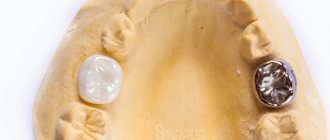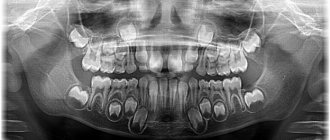First signs
It is advisable to recognize the onset of teething in a child in time in order to be able to provide him with the necessary help. As a rule, symptoms of the upcoming appearance of the first tooth in a baby appear within a few days - in most children this period lasts up to several days and ends with the eruption of the outer shell of the gums.
Parents can recognize that their baby is starting to teethe by the following signs:
- The appearance of sudden changes in the child’s behavior: sleep disturbance, irritability, crying, refusal to take the breast or pacifier;
- The formation of increased salivation, often accompanied by the appearance of rashes around the baby’s mouth, chin, and chest due to excessive saliva;
- At the site of tooth eruption, the gums swell and become swollen;
- The child bites everything that gets into his hands, trying to relieve the irritating itching that appears in the gums.
When do primary molars become molars?
To keep the chewing organs strong, fluoridation of the teeth is often required. This technology ensures the prevention of carious lesions due to additional mineralization of the enamel layer. Fluoride ions create an antibacterial environment in the oral cavity, prevent acid damage to crowns, reduce the vulnerability of units, and reduce the formation of soft plaque and stones. After the procedure, patients develop gum disease much less often.
When the milk organ is replaced by the root organ, children experience slight discomfort. The first permanent posterior tooth appears after six to seven years. New units grow under the temporary ones, appearing above the gum after they fall out. You should not speed up the process of hair loss, as this can cause:
- Incorrect growth of permanent units;
- Malocclusion;
- Disproportional growth of the jaw bone;
You should visit the dentist regularly during this period. If the units grow crookedly, the doctor will immediately respond to the problem, correcting the child’s bite in a timely manner. Scheme for cutting through constant molar units:
- In the period of 6-8 years, permanent sixes appear;
- When the child turns 12-13 years old, sevens, both upper and lower, are cut through;
- After 17 years, only a few wise people make it through. Their growth can last up to 30 years or more;
Eights may not erupt at all, remaining under the gum tissue or in the jawbone. It is important to visit the dentist regularly to prevent serious complications.
What you need to know about deadlines
With the correct development of the newborn’s body, teething occurs at certain times according to the principle of pairing. Usually identical teeth erupt at the same time - this applies to pairs of central and lateral incisors and canines.
At birth, there are 20 follicles in both jaws of the baby - 10 for each jaw, which are the rudiments of temporary teeth. The newborn also has 16 permanent tooth buds. Another 16 primordia begin to form after birth.
The order of eruption of baby teeth:
Important:
Here are the average dates for teething in newborns. However, the development of each organism is strictly individual, so it is possible that these dates may shift in one direction or another in approximately 50% of cases. Therefore, do not panic if deviations from the given deadlines are insignificant.
There are cases when a baby was born with the first tooth. This makes breastfeeding much more difficult, so you need to get appropriate advice from your doctor.
With artificial feeding, there may be a delay in teething, while a breastfed baby's teeth erupt earlier in 10 cases out of a hundred. In addition, the delay in the eruption of baby teeth is influenced by the condition of the mother during pregnancy - for example, toxicosis, infectious diseases, stress, as well as diseases suffered by the baby.
When does a child's molars come out?
Growing permanent teeth is a big job for the body, which we rarely notice. Changes begin at 3 years - the rudiments of molars are formed. At age 5, noticeable gaps appear between the baby teeth to make room for new “tenants.”
Which teeth come out first is determined by a lottery - genetics. In half of the cases, growth begins with “sixes”. Molars grow by the age of 7-8 years, at the same time the front incisors change.
Teeth grow slowly but painlessly. At 14, the main bite is already formed. “Late” wisdom teeth - third molars grow in a few years, at 18-21 in most adults.
What should you pay attention to when teething?
The above symptoms of the onset of teething are characteristic of almost all infants. However, some children have additional symptoms that need to be taken seriously:
- Temperature increase;
- Formation in the mouth of small watery blisters with cloudy or clear liquid;
- Increased redness and inflammation of the gums;
- Inflamed oral mucosa, accompanied by the formation of slight erosion.
In a healthy baby, when teething, contrary to popular belief and the advice of “experienced” relatives, the temperature does not rise. If this happens, it means that the child’s body is simultaneously exposed to some kind of inflammatory disease.
Most often, the listed signs indicate the development of a viral form of stomatitis or ARVI, which is not surprising given the child’s desire to put everything in his mouth. Therefore, you need to show the child to the doctor. If the pediatrician does not detect signs of an acute viral infection, take your baby to a dentist so that he can determine what form of stomatitis your child has caught and prescribe adequate treatment. Unfortunately, pediatricians are most often incompetent in this situation.
Removing or retaining wisdom teeth
Even before the “eight” stage, you can discuss with your doctor how many of your 4 wisdom teeth to keep and how many to remove. Dentists believe that it is necessary to preserve third molars when:
- no signs of crowded teeth;
- the crowns of wisdom teeth are positioned vertically;
- first and second molars are missing.
Factors such as the lack of free space on the jaw play in favor of removing “eights”: the existing teeth are tightly spaced, there are no plans to remove the molars, their condition is good or excellent.
Other indications for removal:
- incorrect position of the tooth crown - horizontal or inclined, creating pressure on the roots and crown of the adjacent molar;
- prolonged lack of progress in teething in the presence of intense symptoms;
- repeated inflammation and suppuration in the eruption area;
- caries of the crown of the third molar.
They can be removed both before and after eruption. This procedure is painless and does not take much time. The procedure is performed under local anesthesia. Some clinics use sedation to make the procedure as comfortable as possible for the patient.
Possible complications
"Surprises"
The problems that nature presents when infants have their first teeth do not end with the listed troubles. Sometimes other complications are possible:
- Formation of hematomas.
A bluish-colored bubble swells on the gum. Most often it resolves over time, but sometimes if the blister is too large, surgery is required. The doctor makes a small incision on the gum to remove the bloody fluid.
- The appearance of vomiting.
This may be caused by excessive salivation. However, if vomiting is accompanied by diarrhea and fever, these may be signs of rotavirus, so it is necessary to urgently show the child to the pediatrician.
- Cough reflex.
With normal teething it does not happen. The cause of the cough may be excessive saliva secretion, which causes the baby to choke.
If a runny nose appears, take your child to the doctor
- teething probably coincided with a cold.
Important:
If your baby is experiencing fever, diarrhea and vomiting during teething, take this seriously. The cause of their appearance cannot be teething. It is urgent to call a pediatrician, since the baby’s body is at risk of intoxication due to a developing infection.
Features of molars
Large molars differ from other groups not only in external characteristics, but also have other features :
- these are the largest units in each dental arch;
- have the largest chewing surface;
- have a powerful root system;
- the upper molars are slightly larger than those on the lower jaw;
- have a stronger surface coating;
- able to withstand weight up to 75 kg;
- upper molars have 4-6 canals, while lower units generally have only 3 canals;
- maxillary molars have 3 roots (palatal, buccal-medial, buccal-distal), less often 4;
- the chewing teeth of the lower jaw have only 2 roots;
- wisdom teeth are the very last molars, which may appear by the age of 50 or not appear at all;
- the last molars are very often located not in the chewing arch, that is, they can grow horizontally or with a slight slope, located buccally or towards the tongue or palate;
- wisdom teeth have from 1 to 5 chewing cusps;
- the last molars often have a complex root configuration (curvature, fusion).
All this entails the peculiarities of treatment of such teeth. The presence of a large number of complex root canals, as well as difficult access compared to other groups of teeth, requires highly qualified doctors and modern equipment for high-quality therapy.
In dental practice, molars are considered the heaviest units, especially wisdom teeth. Proper care and regular preventive examinations will help keep them healthy. When the first signs of damage to the molars appear, we recommend that you immediately sign up for a consultation at our KAS+ dentistry. Timely detection of dental problems guarantees their high-quality treatment with minimal risk and long service life.
How to relieve your baby's condition with medications
If your baby is bothered by sore gums and begins to behave restlessly, you can give him a mild pain reliever that is appropriate for his age.
For the youngest, it is better to use candles, and older children can be given a special suspension. These drugs, in addition to a sedative effect, have mild antipyretic properties. In addition, pharmacies sell a special anesthetic gel, a small amount of which should be applied to the surface of the inflamed gum. However, you should not get carried away with such gels, since most of them promote increased salivation and also cause numbness, which makes the baby feel uncomfortable.
Important:
Before purchasing one or another medication to alleviate a child’s teething condition, you should definitely consult a pediatrician to rule out side effects.
What determines the symptoms of teething?
The intensity of symptoms depends on several factors:
- Anatomical features of the jaw. The jaw, which is small in size, can barely accommodate the existing 28 teeth, and the eruption of the third molar causes active displacement of the entire dentition and its crowding. This may be accompanied by pain not only in the corner of the jaw, but also in the front teeth.
- The presence of molars next to the figure eight. In the absence of a second molar, the “figure eight” erupts faster and less painfully, since it encounters almost no resistance.
- Features of the location of third molars relative to other teeth. Dystopic “eights” are located horizontally or at an angle to the main dentition. As they begin to actively grow, they put pressure on the nerves, roots of adjacent teeth, soft tissues, and even the trigeminal nerve, causing unbearable pain.
- Features of the structure of the nervous system (trigeminal nerve). Sometimes the branches of the trigeminal nerve are located close to the place where the wisdom tooth will erupt. Increased pressure on the tooth itself, as well as swelling of soft tissues due to inflammation, can provoke a sharp increase in pain.
An experienced dentist, when assessing an image of the rudiments of wisdom teeth, can predict how problematic and painful the process will be.
Associated symptoms
These symptoms do not appear very often, but they cannot be ignored. If the baby has a fever, an incomprehensible cough, or diarrhea, this can be either a sign of infection or a reaction of a weakened body to pathogenic microflora.
When teeth are forming, the temperature usually lasts for 3-4 days at 38.5°C. This symptom is irregular, so fever in children should be periodic. If it persists for a long time, you need to show the child to the pediatrician. Some doctors believe that cold symptoms have nothing to do with teething and prescribe appropriate treatment for cough and fever.
Adults also don’t understand what cough and runny nose have to do with new teeth. The gums are directly connected to the blood supply to the nose and respiratory tract. As teeth form, blood flow increases in the mouth. The nasal mucosa is close, so its glands also begin to produce more mucus, which children try to get rid of. Remaining mucus settles into the throat, irritating the airways and causing a cough.
Another symptom is loose stools with a frequency of no more than 3 times a day. While scratching his gums, the baby constantly puts dirty fingers and the first objects he comes across into his mouth. In addition to infection, diarrhea is facilitated by increased salivation, which constantly flushes the intestines. If the stool is short-lived and does not contain blood, there is no need to worry about the child’s health. It is necessary to monitor his condition, since with a weakened immune system there is always a risk of developing an infection, which aggravates all the symptoms.








